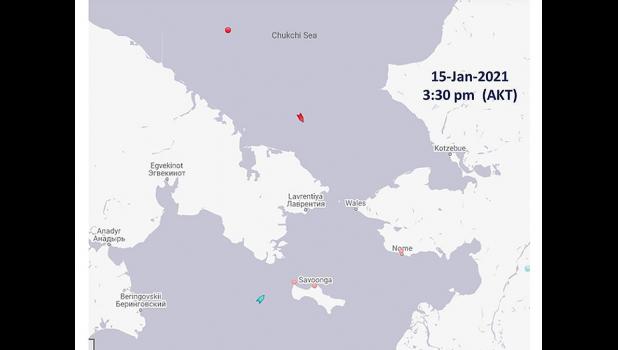Two more Russian tankers transit Bering Strait
Two more Russian LNG tankers made history earlier this month passing through the North Sea Route, which extends along the northern coast of Russian Asia, in late January, the latest commercial ships to navigate the route without the aid of icebreakers.
The Christophe de Margerie and the Nikolay Yevgenov sailed south through the strait on Friday and Saturday about two weeks ago, according to Norton Sound Economic Development’s Wes Jones, who keeps on eye a marine traffic monitoring system to track fishing and shipping activity in the Bering Sea.
The 299-meter tankers were loaded with liquified natural gas from the Yamal LNG gas fields in northern Russia. They’re bound for the Chinese port of Jingtang, where they’ll unload their cargo before heading back north in the beginning of February.
The ships, part of a fleet of 15 new Arc7 icebreaking carriers, broke the record for the latest unaided traversal of the Northern Sea Route since the Nikolay Zubov came through earlier this month.
The Niklay Yevgenov, the second of the two latest ships, experienced unexplained engine failure just north of the Bering Strait, slowing suddenly from 9 knots to 3 knots, according to the Barents Sea Observer. While the circumstances and extent of the problem are unknown, the ship still successfully made it through the strait and is on track to arrive in China, albeit later than scheduled.
Jones said that older, thicker Arctic ice, which the tankers can’t navigate on their own, is quickly encroaching on the northern Russian coast. “If that old ice pushes down, it’ll be interesting to see if they change their plans because of that,” he said. They may send a nuclear-powered icebreaker from the Siberian port of Sabetta to lead the way through the thicker ice for the return trip, which is standard practice for most winter operations along the Russian coast.
The vessels come amid a flagship year for Arctic shipping. According to the state-run Russian nuclear energy company Rosatom, 33 million tons of goods were shipped through the Northern Sea Route in 2020, close to four million more than anticipated at the beginning of the year.
In 2017, just 10.7 million tons of goods were shipped along the route, and Russian President Vladimir Putin has said he aims to increase that number to 80 million tons in 2024. Of particular significance are the Arc7 icebreaking tankers shipping LNG from Siberia to China, taking a much more direct and efficient route than the alternative through the Atlantic.
Aker Arctic, the Finnish company that designed the carriers, announced plans in October for a second generation of vessels to be built in South Korea, which are on track to be even more powerful than existing vessels and open up Arctic shipping even further.
The opening of the Arctic, driven by sea ice loss due to climate change, has captured the attention of the U.S. Coast Guard. This year, the Coast Guard’s heaviest icebreaker, the Polar Star, sailed north from Antarctica to patrol the Bering Sea during the winter months. Coast Guard Public Affairs Officer LCDR Scott McCann said the Polar Star reported “many observations” of the Christophe de Margerie, one of the LNG tankers passing south through the strait.
All in all, the Coast Guard reported 197 vessels transiting the Bering Strait in 2020, the majority of which were cargo ships.
Many in the region have expressed concerns that the increase in shipping through the strait, especially in the dark, stormy winter months in a region so far from most search and rescue bases, will increase the chance of an accident that could have disastrous consequences. McCann recognized this risk but said the Coast Guard has been working closely with the Russian Border Guard to coordinate potential search and rescue operations and monitor Arctic waters. “The Coast Guard has maintained this relationship and plans for decades,” McCann said. “What’s new is the extended duration of the shipping season, routes, and increase in shipping traffic.” He said the U.S. Coast Guard and Russian Border Guard share a number of agreements with regards to security and pollution preparedness in the region. “It’s worth noting the United States respects freedom of navigation in areas like the Bering Strait,” he added.
They also have plans to expand its presence in the Arctic region. Currently, the Coast Guard’s only two icebreaking vessels are the Polar Star and the Healy, a medium icebreaker that spends most of its time in the Arctic.
Meanwhile, the Canadian military has seven icebreakers, and Russia has 53, with more under construction.
In December, Congress approved $1.2 billion for the production of three new heavy icebreakers and three new medium icebreakers, although it will likely be years before any new Coast Guard vessels are operational.
Additionally, the Coast Guard has increased C-130 flights in the area, and “we always have a surface asset on patrol in the Bering Sea,” McCann said. “We could always use more assets, but we’re doing the best with what we got by employing them strategically.”
The coming years are likely to continue shattering commercial records, as the ice cap shrinks, icebreaking technology improves, and Russian companies continue to prove that Arctic shipping is feasible even in winter months.
This year, the Northern Sea Route will probably be iced in at some point in February before opening up again later in the spring, but that window is only likely to shorten.

